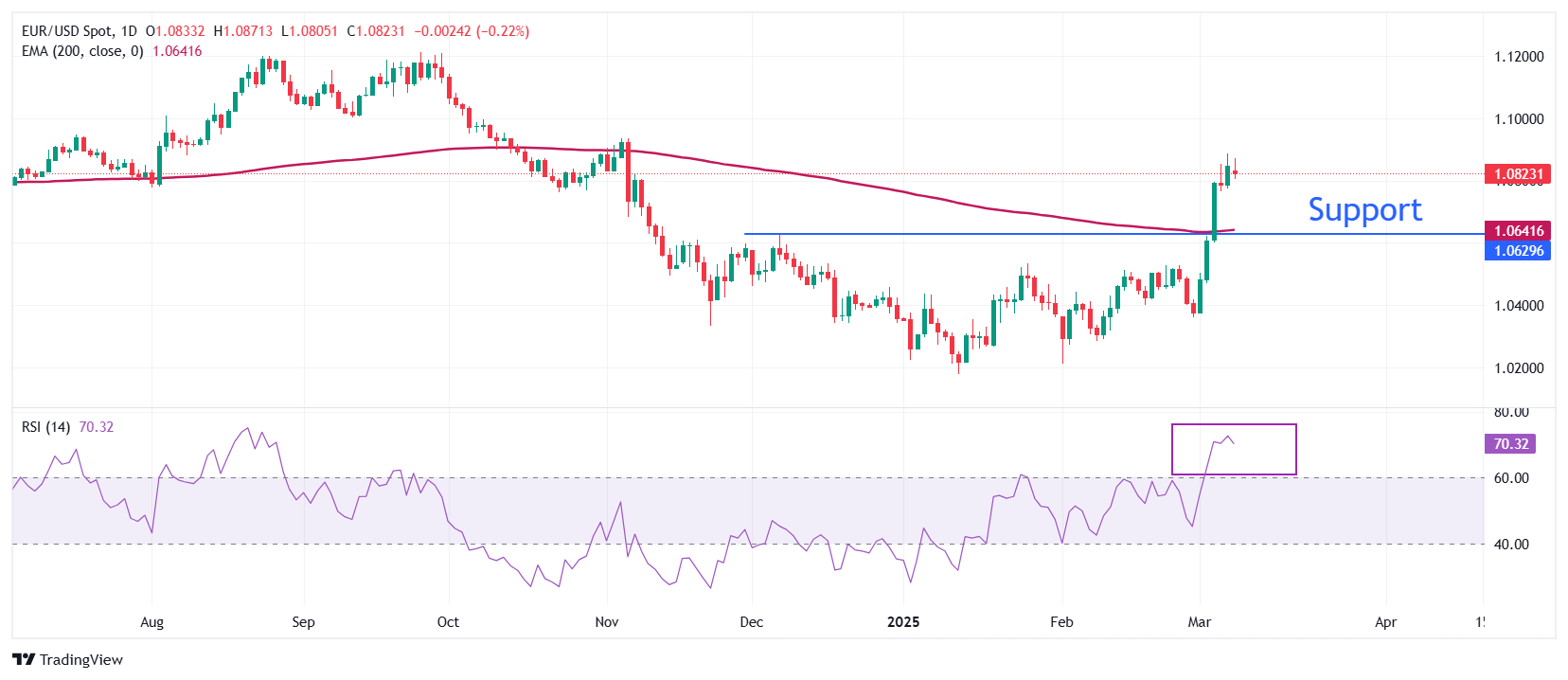- EUR/USD climbs toward 1.0850 as the US Dollar weakens amid growing concerns over the US economic outlook.
- President Trump’s policies are anticipated to slow US economic growth.
- ECB’s Centeno suggests Eurozone inflation is nearly under control.
EUR/USD remains steady near 1.0850 after recovering from early losses in Monday’s European session. The pair gains strength as the US Dollar (USD) faces difficulties in rebounding from last week’s sharp decline. The US Dollar Index (DXY), which measures the Greenback against six major currencies, remains weak near a fresh four-month low of 103.50.
The US Dollar’s outlook remains fragile as investors grow increasingly concerned about how President Donald Trump’s ‘America First’ policies will shape the economy. In a recent Fox News interview, Trump acknowledged potential short-term economic shocks, stating, “There is a period of transition because what we are doing is very big.” His remarks followed questions about a possible recession.
Recent US economic data has signaled a slowdown, including:
- Consumer Confidence hitting a 15-month low.
- A surprise decline in ISM Manufacturing New Orders.
- Slightly weaker-than-expected Nonfarm Payrolls (NFP) data for February.
These factors have fueled expectations for a Federal Reserve (Fed) rate cut in June. According to the CME FedWatch Tool, the probability of a rate cut has surged to 82% from 54% a month ago.
Meanwhile, Fed Chair Jerome Powell maintained a cautious stance, emphasizing a “wait and see” approach on interest rates due to ongoing uncertainty surrounding Trump’s tariff and tax policies. Speaking at the University of Chicago Booth School on Friday, Powell stated, “Uncertainty around Trump administration policies and their economic effects remains high,” adding that the “net effect of trade, immigration, fiscal, and regulation policy is what matters for the economy and monetary policy.”
Daily Market Movers: EUR/USD Faces Pressure Amid Euro Pullback
- The Euro (EUR) sees minor weakness against its major peers at the start of the week, as traders book profits after last week’s strong rally. The Euro’s recent strength was driven by Germany’s decision to stretch its borrowing limit, introducing a €500 billion infrastructure fund to boost defense spending and economic growth.
- Germany’s fiscal stimulus has led traders to scale back expectations for further European Central Bank (ECB) rate cuts this year, fearing inflationary effects. Last week, the ECB reduced its Deposit Facility Rate by 25 basis points to 2.5% but refrained from committing to a preset monetary easing path.
- ECB policymaker and Bank of Portugal Governor Mario Centeno indicated that further rate cuts remain on the table. Speaking at a conference on Friday, Centeno noted that the Eurozone is moving toward “normalizing monetary policy” and that inflation is “almost out of the woods,” nearing the ECB’s target.
- On the data front, Germany’s Industrial Production grew by 2% in January, surpassing the expected 1.5% increase and recovering from December’s 1.5% decline. Additionally, Eurozone Sentix Investor Confidence improved significantly to -2.9 in March from -12.7 in February.
Technical Analysis: EUR/USD Shows Resilience Near 1.0800

EUR/USD stabilizes around 1.0850 after briefly dipping toward 1.0800 on Monday. The pair remains bullish following a strong breakout above the December 6 high of 1.0630 last week.
- The pair holds above the 200-day Exponential Moving Average (EMA) at 1.0640, reinforcing a long-term bullish outlook.
- The 14-day Relative Strength Index (RSI) hovers near 70.00, signaling strong bullish momentum.
On the downside, 1.0630 serves as key support, while resistance levels to watch include the November 6 high of 1.0937 and the psychological barrier at 1.1000.





